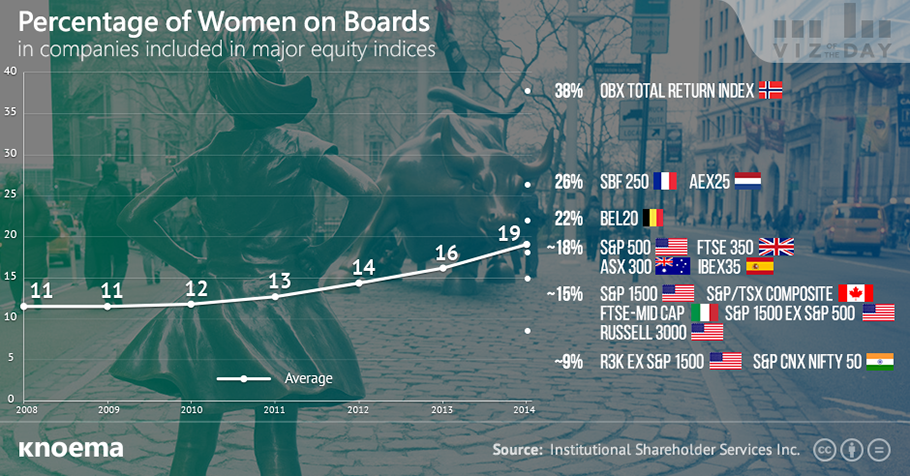Gender Diversity and Corporate Boards | Global Trends
АрхивIt will of course require more than a bronzed statue of a strong-willed girl taking on the bull of Wall Street to force a sustained and amplified role for women in the upper echelons of the corporate world. But, how far have we come globally in opening c-suites and corporate board rooms to women?
On average, during the period from 2008 to 2014, the participation rate of women on corporate boards increased in most of the publicly traded corporations included in major equity indices. Some notable differences emerge when accounting for gender quotas and industry trends:
- Markets with gender diversity quotas had a higher proportion of females on boards than those without mandatory quotas. Since 2011, the percentage of women on boards has risen by as much as 12 percent for companies in quota markets and only 3 percent in non-quota markets. Even among the worst preforming of the ranking, however, progress was evident. The companies on the Indian S&P CNX Nifty 50 increased female representation from 4.4 percent in 2008 to 8.3 percent in 2014.
- In quota-based markets, large capital firms had the highest proportion of women on boards and the largest increases in gender diversity. The strongest female representation in 2014 was among the companies of the Norwegian OBX Total Return Index, which reported 37.9 percent of board members were female.
- The household & personal products industry reported the highest female participation rate among corporate boards, while energy reported the lowest rate.
- The percentage of new female nominees to corporate boards almost doubled during the past seven years among US large-capital companies.
As the girl on Wall Street serves to renew interest and fervor over gender equality in the corporate world, we keep an eye on representation in government as well. Governments can further corporate-led initiatives with government-backed funding, programs, and legislation to enable progress on training opportunities, equal pay, and work-life balance to build and sustain female engagement in all levels of business. The devil is in the details—policies and regulations sort of details—but it is promising that as with corporate boards, during the last two decades, the share of women parliamentarians has doubled, increasing from 10.8 percent in 1997 to 21.2 percent in 2016.
Материалы по теме
Women in Parliament Around the Globe
Politics has long been considered as a 'man's world.' Even today, women remain significantly underrepresented in legislative and executive branches of government globally despite research that suggests a strong connection between women in leadership and economic and democratic gains.Today one-fifth of the world's parliamentarians and less than one quarter of national leaders are women. Rwanda, Cuba and Bolivia have the highest share of women parliamentarians, however, Europe has traditionally maintained the highest representation of women in government. As of June 2016, the ratio of men and women lawmakers in Belgium, Sweden, Finland, and...
Age at first marriage
Age at first marriage varies significantly across countries. In general the higher is per capita income, the older are people who get married at first time. In developed European Countries like Germany, France, Italy, Sweeden, Norway and Finland the age at first marriage exceeds 30 years. On the other hand in low income African countries the age at first marriage is between 17-20 years for females and 23-25 years for males.
61st Commission on the Status of Women
The Commission will address as its priority theme ‘Women’s economic empowerment in the changing world of work’. In addition, it will evaluate progress in the implementation of the agreed conclusions from the fifty-eighth session (2014) on ‘Challenges and achievements in the implementation of the Millennium Development Goals for women and girls’ ThemesPriority theme: Women’s economic empowerment in the changing world of workReview theme: Challenges and achievements in the implementation of the Millennium Development Goals for women and girls (agreed conclusions of the fifty-eighth session)Emerging issue/Focus area: The empowerment of...
UN Women Executive Board, first regular session
Date of Event: 8-12 February 2016 Event Holder: UN Economic and Social Council Description: The Executive Board governs the operational activities of UN-Women and provides operational policy guidance to the Entity.
